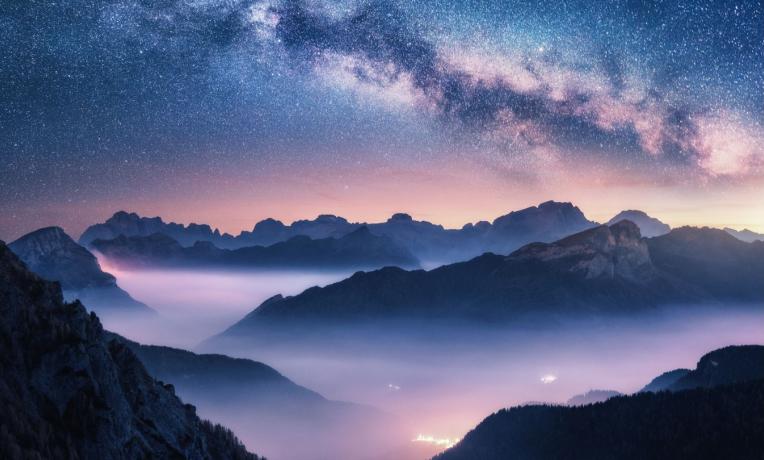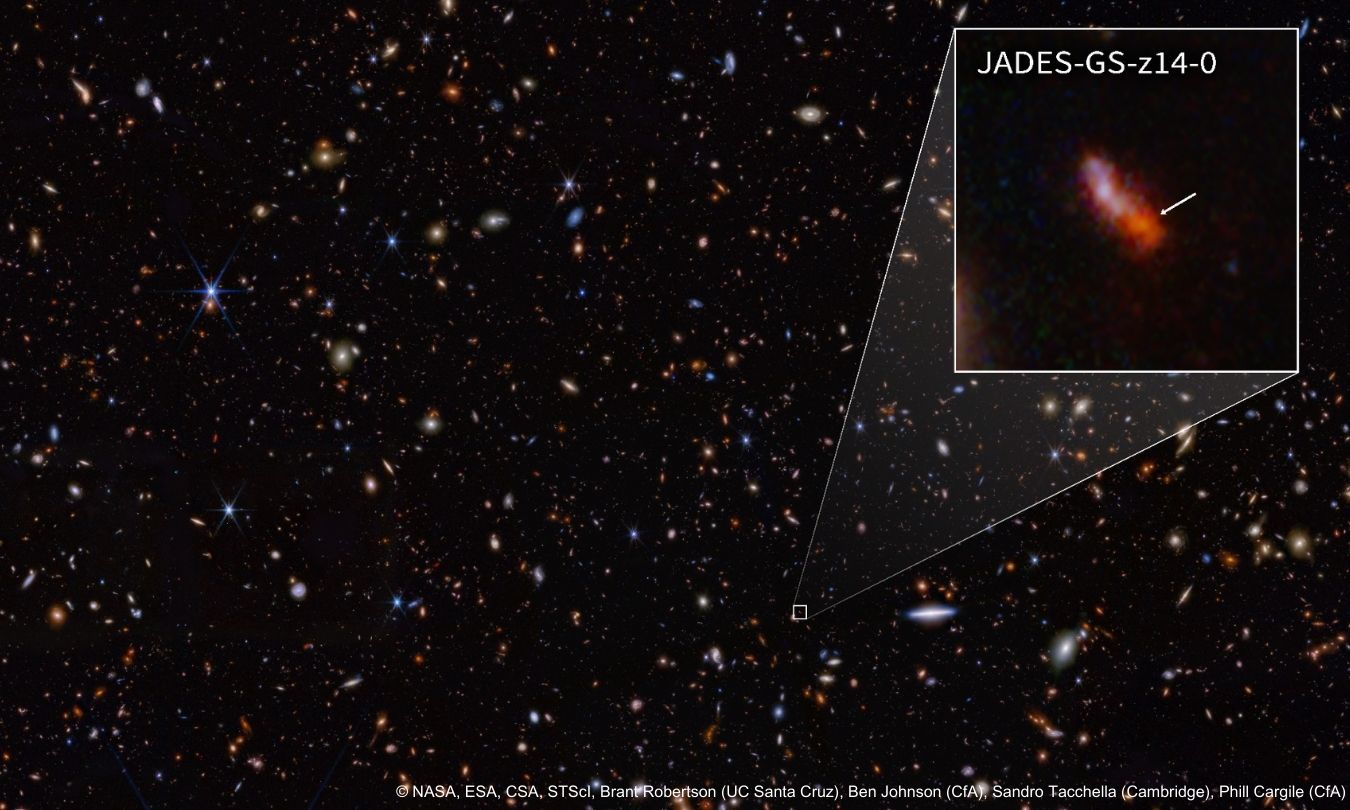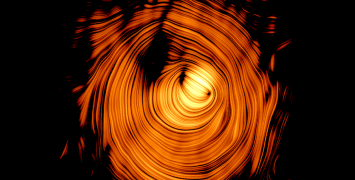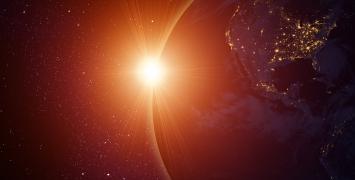The first stars of the universe

By Ruth Domínguez Anguera
‘Did you know that every atom in our body – oxygen, sodium, or any element other than hydrogen and helium – was once at the heart of a star?’, Ferrara asks with a smile. ‘We are made of stardust. Just think, something that makes up my nose, for example, was once inside a star. Fantastic, right?’ Before diving into his research on the universe’s first stars, Ferrara shares this fascinating fact.
‘There are countless stars in the universe, but the ones we see when we look up at a starry night sky are only those within our home, the Milky Way. There are other galaxies like ours – some larger, some smaller, and some formed a very long time ago,’ Ferrara explains. He is trying to understand how these galaxies function, why they formed so early, and how they produced their stars, starting with the available fuel: the interstellar matter.
‘Galaxies are made of essentially three things: stars, gas and dust grains’, Ferrara notes. ‘The interstellar medium is composed of gas and dust. It contains gases like hydrogen and helium, along with heavier elements such as carbon, nitrogen, and oxygen – the very building blocks of life. Dust grains, on the other hand, are solid particles that condense from dense matter ejected during the explosion of the most massive stars, known as supernovae.’
Approaching the Big Bang
Ferrara’s team is exploring the infancy of the universe, ‘pushing the frontier a little bit further,’ as he puts it, to get closer to the Big Bang and discover the first stars that formed within the earliest galaxies. ‘Understanding when and how this happened is one of the main goals of present-day cosmology,’ he explains.
However, he notes that ‘there’s no exact date, year, day, or month for when the first galaxies in cosmic history formed.’ Currently, Ferrara’s team is observing galaxies that were already in place and functioning about 300 million years after the Big Bang. While this might seem like a long time, it is just a fraction of the universe’s 14.8 billion years of history. Ferrara says: 'If we think of the universe today as an 80-year-old man, we’re now observing him at just 20 months old. He was a baby.’
One of their latest discoveries is that these ´baby´ galaxies are rich in heavy elements and dust. This fact was previously unknown, but it is now starting to be widely accepted and agreed upon, Ferrara points out.

The most distant galaxy
‘We would like to see the very first galaxy where everything started,’ he says. ‘Up to that point, the universe was kind of a boring place. It was completely dark and essentially an expanding ball of hydrogen and helium. There was nothing else in it — no stars, no visible light, nothing. The fun began when the first stars formed and created the first galaxies.’
Learning more about the first galaxy has become possible with the James Webb Space Telescope (JWST). Ferrara notes that now is the right time to make discoveries and close the circle, since the JWST will not last forever.
‘Afterwards, we can claim that we have seen everything that has happened in our universe, at least at the level of exploration. Understanding such ´everything´ will remain an issue, but having the data and pushing as far as we can while the JWST is still operational is very important,’ he highlights.
His team is currently studying the most distant galaxy we know, called GS-z14-0. ‘Astronomers like to give these telephone-number-like names to galaxies,’ he jokes. ‘But we call it GS14, for short.’ Ferrara explains that they didn’t expect to find a galaxy so large and bright in this extremely early phase of cosmic evolution. But there it is, and what they are discovering is how this galaxy came into being, what its properties are, and how it fits into the cosmological model. ‘It is very exciting,’ he says with enthusiasm.
High spatial density
What were these distant galaxies like in their early days? As mentioned earlier, one discovery by Ferrara’s team is that these “baby” galaxies are rich in heavy elements and dust. However, they have also found that the physical conditions of these “baby” galaxies were very different from those of our Milky Way. The main differences lie in their size and density.
Observations reveal that these galaxies are small – almost 100 times smaller than those around us. ‘Galaxies grow through a process of coagulation’, Ferrara explains. ‘They start as tiny pieces; the very first galaxies formed, then merged over time to create larger and larger galaxy systems.’
Due to their small size, the stars are heavily packed, or more rigorously, their spatial density is very high. Ferrara clarifies this concept by drawing a parallel with Proxima Centauri, the closest star to us after the Sun, located five light years away. ‘If you were living in one of these early galaxies, in the volume where we find only one star [Proxima Centauri] in the Milky Way, you would find a thousand. Just to give you an idea of how densely populated the stars were in the early universe.’
‘There are other differences, but these are the main ones: size and the violent environment. Very dense, very turbulent, with a very strong radiation field. They were not exactly pleasant places to live, I have to say,’ he laughs.
Cosmological model
And why were galaxies like that in those early days?
‘We [astrophysicists] work with the standard cosmological model, or the concordance cosmological model, which suggests that everything formed and that we see around us today is essentially the result of the force of gravity’, Ferrara explains. ‘In this framework, it is predicted that galaxy formation is hierarchical – a process that starts from very tiny objects and progresses to very large ones, continuing indefinitely. Even our galaxy is not the endpoint in this evolution; in the future, it will merge with another, most likely Andromeda, our closest neighbour. The history of the universe, in short, is simply the evolution from tiny pieces to large ones – galaxies.’
‘In the last 10 years, we have discovered that the universe is not only expanding, but that this expansion is constantly accelerating, so it is going faster and faster and faster’, Ferrara continues. ‘Therefore, within the next 5 billion years, the Milky Way will collide with Andromeda, and together they will form a single galaxy.’
The astrophysicist clarifies that this process of galaxies constantly merging to form larger galaxies will eventually stop because the expansion of the universe will tear galaxies apart at such vast distances that they no longer be able to collide.
‘The universe will become so huge that it will be impossible to see the light from other galaxies. So, the future inhabitants of Earth – assuming there is an Earth at that time, which I doubt – or any inhabitant of the universe will never see the other galaxies. They will be stretched to such incredibly large distances that they will no longer be visible to one another. That is the future of our universe, according to what we know today.’
The future of planet Earth
‘Studying the universe gives us the awareness that we are living in a vast cosmos,’ Ferrara says. ‘And our planet is tiny but special, that's for sure.’
Even though there is no direct application for most of what astrophysicists work on, Ferrara hopes these concepts will help us adopt the right framework for thinking about human culture and offer perspectives for the future. For him, ‘it can be as simple as loving nature on our planet and understanding its fragility and beauty.’
So, you might be asking yourself: What will the future of planet Earth look like?
‘Even before it merges with another galaxy, in less than 5 billion years, the Sun will begin to expand. Its surface will reach Earth and beyond. We will be inside the Sun, and that means Earth will melt and eventually disappear with it. If we are still around, that will be our fate, too. In the end, Earth will no longer exist.’
‘As for the collision with another galaxy, it wouldn’t necessarily destroy Earth, but it could cause Earth to be detached from the Sun. The Earth could end up drifting in space, lost in the immense intergalactic void between galaxies. The collision would create such a mess that all the fragments would scatter, and planets could be stripped away from their stars. We would become a floating planet in the middle of the universe, in the dark. Not a very good outcome either.’
Light of hope
‘However, the intelligence of the entire universe is also growing. I believe we will learn things that we can't even imagine now because our brains have limitations. It’s like trying to teach a monkey to solve differential equations : there’s no way because their brain has a cognitive limit. The same applies to us. There are questions we can’t even begin to ask,’ Andrea Ferrara concludes with a smile.
Biography
Andrea Ferrara is a theoretical astrophysicist and one of the top Italian scientists in the field of cosmology with 580 published papers (Hirsch H-index of 102). At Scuola Normale Superiore in Pisa, where he is a professor, Ferrara directs the Cosmology Group, specialised in the study of the early universe through theoretical models, supercomputing simulations, and data visualisation. His work on Population III stars, high - redshift galaxies, feedback processes, cosmic reionisation, and dark matter has set a benchmark in astrophysical research, influencing observational strategies in modern cosmology.






